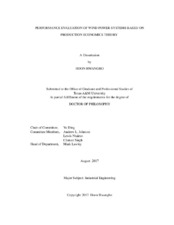| dc.description.abstract | The research in this dissertation addresses the issues in the performance evaluation of wind power systems under commercially operating circumstances. Such an evaluation is critical to a wide range of decisions including operations and maintenance planning, reliability assessment, asset procurement, and system designs. However, accurate evaluation is excessively challenging due to the unknown causal relationship between wind input and power output, the dependency of power output on numerous uncontrollable factors, and the high level of uncertainty observed in power output. While addressing these challenges, we develop a new performance measure based on production economics theories and propose effective methodologies for evaluating the performance of wind power systems. By doing so, this dissertation study aims to improve the practice of performance evaluation in the wind industry.
We define an efficiency metric analogous to productive efficiency, which requires estimating a performance benchmark, i.e., the performance referring to 100% efficiency. For the performance benchmark, we develop a stochastic nonparametric estimator maintaining S-shape, the typical shape observed in the wind input-power output relationship. When applying the efficiency metric for comparing performance under different scenarios, other environmental factors need to be controlled for, as their difference could produce a difference in power output. We devise a covariate density matching method that selects subsets of data for which probability densities of the environmental factors are comparable; evaluating only these subsets, then, ensures a fair comparison. We further investigate wake situations in which the operation of a turbine could cause a significant power deficit on its neighboring turbines. In the presence of the performance benchmark introduced earlier, ii we can model the power deficit as a non-negative term subtracted from the benchmark. Based on this model setup, we develop a spline model with a non-negativity constraint imposed for characterizing such a wake effect.
When each of the proposed methods is applied to operational wind data, the respective results demonstrate that each of the methods outperforms its competitive alternatives in terms of estimation and/or prediction accuracy. This suggests that the methods can reduce the unaccounted uncertainty in power output and thus provide better insight into the performance of wind power systems. | en |


